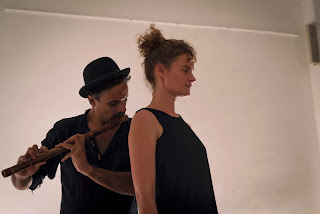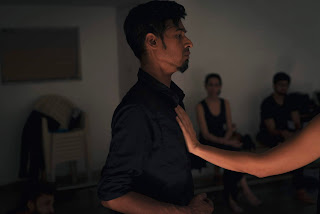Saturday, November 24, 2018
Saturday, November 17, 2018
Notorious Rowdies
Notorious Rowdies” – a series of performative photographs by Clare Arni – first exhibited at gallery TARQ, Mumbai in 2017. The term ‘rowdy’ has a particularly evocative quality in South India. The ‘rowdy’ is an unsavory character, an outlaw, with a strangely alluring bravado. Clare Arni’s fascination with the figure of the ‘rowdy’ began a few years ago while scouring the crime beat section of a local daily, the Deccan Herald. This captivating section carried sordid tales of the nefarious activities of local gangsters, many of whom carried cryptic and outlandish aliases like Dairy, Chicken, and JCB. The crime beat section and its sensationalist reportage style were for Arni, an echo of the garish aesthetic of film posters that are plastered across Bangalore, the city she calls home. The posters glamorized violence, with larger than life characters in ludicrous scenarios.
Fascinated by the specific persona of the ‘rowdy’, Arni began toying with the idea that perhaps there is violence and drama in all of us; a rowdy under the surface, waiting to leap out. She began her project by photographing friends – fellow artists and writers – in various modes of the ‘rowdy’. The participants were asked to delve into the inner life of the rowdy they had chosen to embody, creating elaborate backstories and crime sheets. What began as a fun project has turned into a series of performative photographs that are simultaneously humorous and macabre, with an aesthetic reminiscent of a low budget film. They unearth the dark fantasies of the subjects while also serving as a mirror to the universal voyeuristic fascination with violence.
Fascinated by the specific persona of the ‘rowdy’, Arni began toying with the idea that perhaps there is violence and drama in all of us; a rowdy under the surface, waiting to leap out. She began her project by photographing friends – fellow artists and writers – in various modes of the ‘rowdy’. The participants were asked to delve into the inner life of the rowdy they had chosen to embody, creating elaborate backstories and crime sheets. What began as a fun project has turned into a series of performative photographs that are simultaneously humorous and macabre, with an aesthetic reminiscent of a low budget film. They unearth the dark fantasies of the subjects while also serving as a mirror to the universal voyeuristic fascination with violence.
Friday, September 28, 2018
Next-Step residency artist Open Studio
Open Studio for the NEXT-STEP residency program generously supported by the Sher-Gil Sundaram Arts Foundation. From an applicant pool of close to 200 hundred applications, the following six artists were selected to live and work in 1Shanthiroad's studios for the entire month of September.
Artists-in-residence:
Janhavi Khemka
Mariraj Rajasekaran
Muskaan Singh
Mustafa Khanbhai
Nilanjan Das
Sitikanta Samantsinghar
Janhavi Khemka
Mariraj Rajasekaran
Muskaan Singh
Mustafa Khanbhai
Nilanjan Das
Sitikanta Samantsinghar
Friday, June 29, 2018
The Long and Short of It With Priyabrat Panigrahi Written by Poorna Swami & Marcel Zaes
The Long and Short of It (Sequence)
The first draft for a durational sound and movement installation. Featuring an amplifier, a human, and other
(distorted) occurrences, arranged on territories of delicate noise. An attempt to accumulate histories as they dissipate.
With Priyabrat Panigrahi
Written by Poorna Swami & Marcel Zaes
The first draft for a durational sound and movement installation. Featuring an amplifier, a human, and other
(distorted) occurrences, arranged on territories of delicate noise. An attempt to accumulate histories as they dissipate.
With Priyabrat Panigrahi
Written by Poorna Swami & Marcel Zaes
Monday, June 18, 2018
Visual world of difference-Lecture by YS Alone.
About the talk
In colonial India, Brahmanic hegemony has produced meta-narratives of the nationalist imaginations having its roots in the intellectual politics of homogeneity of tradition. The intellectual politics of homogeneity of tradition denied the multiplicity while making tradition as of projecting the nationalist aspirations. The nature of understandings have produced monologues of privileges and the space for articulations gets reduced to the nationalist imaginations which make representations timid and devoid of ‘others’ or for that matter the lower castes. The claimed post-colonial subjective realm hardly produced any capacity to address the difference as well as offered a constructive critic of hegemonic thinking as being practiced by the Indian natives and completely bypassed the issues of representations. The hegemonic historicism has produced a metanarrative of thought process devoid of any interrogation, making the world of dominance. The ways in which modernity is produced in India is embedded in traditionalism and hence modernity in India remains cosmetic in nature and has not empowered to any transformations. Dr. Ambedkar was the first who presented critic of Brahmanical discourses, Imperial discourses, and Marxian discourses. He offered a very different idea of critique. Inspired by his ideas, the followers of Dr. Ambedkar began to engage in visual culture by producing imageries that have been representing the Ambedkarite consciousness. Apart from raising Ambedkar statues, the newly converted followers also started revisiting the symbols of the Buddhist past and adopted them with new fervor
and thus started aiming at creating a distinct cultural identity. In case of gallery art practices, very few dared to be different. The lecture illustrates Ambedkar, Neo-Buddhist imagery along with some distinct examples of gallery art practices.
and thus started aiming at creating a distinct cultural identity. In case of gallery art practices, very few dared to be different. The lecture illustrates Ambedkar, Neo-Buddhist imagery along with some distinct examples of gallery art practices.
About the speaker
Prof. Yashadatta Somaji Alone is a Professor in Visual Study in School of Arts and Aesthetics, Jawaharlal Nehru University New Delhi. He has published several research papers in journals and chapters in edited volumes on Ancient Indian Art and a critic of Walter Spink, Ajanta caves and Buddhist caves in western India, critic of modern Indian art, popular neo-Buddhist visual culture, in addition to the above, research papers on the interpretative framework of Dr. Ambedkar and social sciences has been published. His research interests include ancient Indian art, Buddhist art, modern Indian art and popular visual culture, a critic of post-colonial paradigms, Neo-Buddhist visual culture as well general social sciences. Prof. Alone is currently involved in the conceptual formulation of ‘protected ignorance’. He has lectured widely in India and abroad mainly China, USA, Germany, Spain, Sri Lanka. He was nominated as ICCR chair visiting Professor in Shenzhen University China and was also invited as visiting professor at Autonoma University Madrid, Spain, Renmin University of China Beijing. He has been engaged in popular lectures as part of social movements. He has been the advisor of National Council of Educational Research and Training textbook on History of Art for class XI. He has published book-‘Early Western Indian Buddhist Caves: Forms and Patronage’, Kaveri Books, New Delhi, 2016.
Sunday, May 13, 2018
AATMASPHERE (Chapter V)
AATMASPHERE (Chapter V)
AN EXPLORATION OF POLYTONALITY & MOVEMENT
AS AN EXPERIMENT IN CONNECTING SOULS
The Aatmasphere is a sonic experiment exploring the hidden power of
The Fourth Way Enneagram, a nine-pointed form designed by G.I.
Gurdjieff in 1949. The idea of the installation is to use live music
and movement within a circle by engaging different sets of musicians
and dancers experimenting and improvising in the here and now.
AN EXPLORATION OF POLYTONALITY & MOVEMENT
AS AN EXPERIMENT IN CONNECTING SOULS
The Aatmasphere is a sonic experiment exploring the hidden power of
The Fourth Way Enneagram, a nine-pointed form designed by G.I.
Gurdjieff in 1949. The idea of the installation is to use live music
and movement within a circle by engaging different sets of musicians
and dancers experimenting and improvising in the here and now.
Subscribe to:
Comments (Atom)




























































